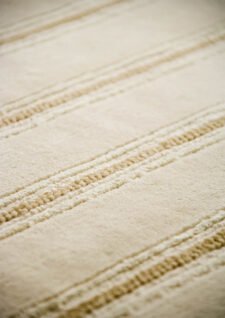Hand-Knotted Area Rugs: What Are They?
Hand-knotting is a centuries-old technique for creating intricately designed rugs. A hand-knotted area rug is a one-of-a-kind piece woven entirely by hand on a unique loom. Oriental and Persian carpets are popular forms of hand-knotted area rugs. Natural materials such as wool, silk, and cotton are used to create these carpets. They have a smoother, less textured pile.
These are woven one knot by the most accomplished carpet weavers utilizing old techniques. Hand-knotted area rugs are exceptional in quality and are works of art that you may walk on. A hand-knotted area rug is one-of-a-kind and is created on a loom, knot by knot, with materials such as pure silk, wool, bamboo silk, and cotton. The number of knots per square inch at the back of the carpet determines the quality of these carpets, which have a flatter pile. A rug with a higher density of knots per square inch is of higher quality.
Producing a hand-knotted area rug necessitates a high level of expertise and, in many cases, a significant amount of time. The number of knots per square inch determines the quality and, in many cases, the price of a hand-knotted area rug. In this example, greater density equates to a higher rate.
A complex pattern may necessitate extremely dense knotting, which can take a long time to complete. A hand-knotted area rug can typically take months to produce, and a weaver can tie 10,000 knots per day on average. So you can imagine how long it takes to finish a single rug, especially if it's a big one. Hand-knotted area rugs are more expensive on average than hand-tufted rugs due to the time it takes to make them.
Flipping a rug over is one of the easiest methods to detect a hand-knotted area rug. There will be no backing on a hand-knotted area rug, and both sides have the same design. Because of the sufficient amount of detail in the knotting, it will appear as if you could turn it over and use it on either side. Because there is not binding on the ends of a hand-knotted area rug, it is likely to have fringe.
The materials used in weaving hand-knotted area rugs
Synthetic materials like polypropylene, nylon, acrylic, and polyester are not used in most hand-knotted area rugs. Instead, natural fibres such as silk or wool are used in most hand-knotted area rugs. Because of their exquisite texture, hand-knotted area rugs made of silk are often more expensive and sought after, yet wool is the most frequent material used in hand-knotted carpets.
Wool is hypoallergenic, antibacterial, and environmentally friendly. Most hand-knotted area rugs are created using sheep's wool, although there are also types made with goat or alpaca wool. Hand-knotted carpets are frequently manufactured from a variety of materials. In hand-knotted carpets, a combination of wool and silk is highly popular. A rug constructed of these two materials mostly comprises wool, with silk is woven in at random intervals to lend a luxurious touch to the finished product.
Is Oriental rug hand-knotted?
The term "Oriental rug" is frequently bandied around. This word can refer to various styles, but hand-knotted Oriental rugs are the only ones that fully qualify. Hand knotting is an ancient technique that has remained substantially unchanged over time. These lovely rugs are works of art that will draw attention to any room they are placed in. Hand-knotted area rugs are extremely durable, soft, and stain-resistant because they are constructed of wool and silk.
Traditional hand-knotted area rugs are not all the same. Many current styles, such as shag rugs, are hand-knotted to hold the threads together. When hand-knotted, even contemporary designs can become family treasures.
Rug Care: How to Take Care of a Hand-Knotted Area Rug
Like any other rug, hand-knotted area rugs must be rotated regularly. Rotate your rug 90 degrees every few months to extend the life of your lovely heirloom. This will ensure that the rug wears evenly, particularly if one corner receives more sunlight or traffic than the others. Like any other rug, a rug pad is advised to protect both your rug and your floor. Your hand-knotted area rug will shed at first, but after a few weeks, the shedding will slow down and eventually stop.
Choose a hand-knotted area rug that is large enough to accommodate your room while searching for a new rug. The space will appear smaller, and the furnishings will appear out of place if you choose a too small rug. Before you go out and buy a new rug, make sure you measure your room.



.jpg)
Comments
Post a Comment